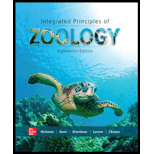
Loose Leaf For Integrated Principles Of Zoology
18th Edition
ISBN: 9781260411140
Author: Cleveland P Hickman Jr. Emeritus, Susan L. Keen, David J Eisenhour Professor PhD, Allan Larson, Helen I'Anson Associate Professor of Biology
Publisher: McGraw-Hill Education
expand_more
expand_more
format_list_bulleted
Concept explainers
Question
Chapter 12, Problem 1FFT
Summary Introduction
To describe: That how might the relationship between a sponge with glassy spicule and microalgae or cyanobacteria be a mutualism.
Introduction: The sponges are any of the primitive multicellular aquatic animals and it constitutes the phylum Porifera. The body types of sponges have three types, namely syconoid, asconoid, and leuconoid. The spicules are structural elements present in most sponges. It deters predators and gives structural support.
Expert Solution & Answer
Want to see the full answer?
Check out a sample textbook solution
Students have asked these similar questions
Mutualisms are interactions between two species where both participants benefit. How might the relationship between a sponge with glassy spicules and microalgae or cyanobacteria be a mutualism?
What genus of protists appears to contradict the statement that unicellularity restricts cell size? a. Dictyostelium b. Ulva c. Plasmodium d. Caulerpa
Which protist group exhibits mitochondrial remnants with reduced functionality? a. slime molds b. diatoms c. parabasalids d. dinoflagellates
Chapter 12 Solutions
Loose Leaf For Integrated Principles Of Zoology
Ch. 12 - The term metazoan is synonymous with animal. Are...Ch. 12 - Prob. 2RQCh. 12 - Prob. 3RQCh. 12 - Prob. 4RQCh. 12 - Describe how the design of sponges influences the...Ch. 12 - Define the following: pinacocytes, choanocytes,...Ch. 12 - Prob. 7RQCh. 12 - Prob. 8RQCh. 12 - Prob. 9RQCh. 12 - Prob. 10RQ
Knowledge Booster
Learn more about
Need a deep-dive on the concept behind this application? Look no further. Learn more about this topic, biology and related others by exploring similar questions and additional content below.Similar questions
- Protists with the capabilities to absorb nutrients from dead organisms are called ______. a. photoautotrophs b. autotrophs c. saprobes d. heterotrophsarrow_forwardWater abandoned in swimming pools often turns green. If you examined a drop of this water with a microscope, how could you tell whether the water contains protists and, if so, which group they might belong to?arrow_forwardWhich group is correctly paired with its description? A. diatoms-important consumers in aquatic communities B. diplomonads-protists with modified mitochondria C. apicomplexans -producers with intricate life cycles D. red algae-acquired plastids by secondary endosymbiosisarrow_forward
- A principle of biology is that biology affects our society. Whyare the cysts of protists important to epidemiologists, thebiologists who study the spread of disease?arrow_forwardWhich of these are actual mutualistic partnerships that involve a protist and a host organism?arrow_forwardCan you answer all the parts to this question about this picture A:This organism is a member of which class? - Answer choices: Cestoda, Turbellaria, Trematoda , Hoplonemertea B:This organism is a member of what genus and species? C: What is the structure shown above?arrow_forward
- Which was not formed by secondary endosymbiosis? A. dinoflagellates B. stramenopiles C. euglenids D. chlorarachniophytes E. cyanobacteriaarrow_forwardYou have discovered a new species aquatic protist that is a primary producer. It cannot swim on its own. It appears to be resistant to physical damage from wave action due to the presence of a glass-like wall. Which of the following organisms would this organism be most like? A) diatom B) dinoflagellate C) apicomplexan D) red algaarrow_forwardWhich is false regarding Archaea?(a) They lack a nucleus.(b) They are considered to be one of the three domains oflife.(c) The often live in extremely hot or salty environments.(d) They lack cell walls.(e) They are responsible for some human diseases.arrow_forward
- What is the term for the symbiotic association between fungi and cyanobacteria? a. lichen b. mycorrhizae c. epiphyte d. nitrogen-fixing nodulearrow_forwardKelp represent which type of protist?a. archaeplastidab. chromalveolatac. opisthokontad. excavatae. rhizariaarrow_forwardYou have discovered a photosynthetic protist that lives in fairly deep water (for example, 250 m deep). To which of the following groups should this organism be classified? A. diatoms B. green algae C. red algae D. cercozoanarrow_forward
arrow_back_ios
SEE MORE QUESTIONS
arrow_forward_ios
Recommended textbooks for you
 Concepts of BiologyBiologyISBN:9781938168116Author:Samantha Fowler, Rebecca Roush, James WisePublisher:OpenStax College
Concepts of BiologyBiologyISBN:9781938168116Author:Samantha Fowler, Rebecca Roush, James WisePublisher:OpenStax College

Concepts of Biology
Biology
ISBN:9781938168116
Author:Samantha Fowler, Rebecca Roush, James Wise
Publisher:OpenStax College